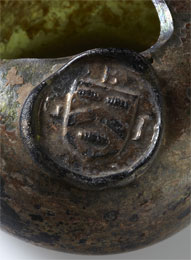
Thomas Dunbar succeeded William Lloyd as Keeper in 1815 (1815-22). He was described as being 'indolent and unscientific', although he is credited as cleaning and tidying up the displays. He was interested in numismatics and tended the coin collection and the library. He was suceeded by Thomas Phillips (Keeper 1822-3), who came and went without any impact.
The long neglected museum was saved by the appointment of John Shute Duncan in 1823. He had a fellowship at New College as well as a career at the Bar. He was Keeper for six years, when he was succeeded in 1829 by his brother Philip Bury Duncan. The brothers transformed the museum. John Duncan recorded at the start of his keepership 'that the skins of the animals collected by the Tradescants had fallen into total decay, that cabinets for those objects liable to injury were wholly wanting and the exhibition department much dilapidated'. For the first time since the founding of the museum a new set of governing principles was drawn up. As in Ashmole's day, nature remained at the centre of the display - the Duncan's aim was to use the natural history specimens to reveal to the visitors 'evidence of the existence of God'.

In 1826 an 'Introduction to the Catalogue of the Ashmolean Museum was prepared. Buckland had removed his collections to the Clarendon building nearby, thus releasing more space for redisplaying the collections. Philip Bury Duncan completed the catalogue in 1836. The catalogue makes it clear the huge extent to which the brothers had transformed the collections with attracted more visitors. A major gift came in 1828 from Sir Richard Colt Hoare, who gave the surviving Anglo-Saxon objects collected by Revd James Douglas in Kent in the 1770s. These represent the first Anglo-Saxon ever put on public display. Ethnographic collections were also received from the various clergymen and administrators in the growing colonial service, as well as sea captains, collecting objects on their voyages.
From 1830 the geological and mineralogical collections moved to the adjacent Clarendon Building, beginning the transformation of the University's collections and foreshadowing the founding of the other University of Oxford museums
By the middle of the century an Honour School of Natural Science was established and under the strong leadership of Henry Acland, Regius Professor of Medicine, agreement was reached for the founding of a new institution. The construction of the new Natural Science Museum on Parks Road (now the University Museum of Natural History) bagan in 1855. It was completed in 1860 with ten departments. The new museum's collections were formed by the surviving natural history collections from the Ashmolean, removed in 1860. Today only a few of the original zoological exhibits survive from the old Ashmolean's collections, amongst them Lhwyd's collection of fossils.
Phillip Duncan retired in 1854 at age 82 and was succeeded by John Phillips (Keeper 1854-70). Phillips was also the University's deputy reader in geology and oversaw the transfer of the natural history material to the new museum. He also transferred the books and manuscripts and the entire coin and medal collection to the Bodleian Library. The antiquities and curios left at the Museum were offered to the Bodleian, but were declined. The Anglo-Saxon collections were added to in 1855 and 1865 by the donation of finds from excavations at Standlake, Brighthampton and Fairford, and for the first time, British archaeological material became a major attraction for the museum.
John Phillips was succeeded by John Henry Parker in 1870. Although he was often away from the museum due to ill health, he was a good custodian of the collections, and in 1878 persuaded the university authorities to establish a museum dedicated to art and archaeology. Parker died in 1884, with this museum not yet established.
Parker was succeeded by the 34 year old Arthur Evans, who revolutionised the museum's focus and oversaw the move of collections to the present location on Beaumont Street. He transferred the ethnological collections to the newly founded Pitt Rivers Museum in the 1880s, and set about refurbishing the Ashmolean as a ' Home of Archaeology in Oxford'. New acquisitions were registered at a rate of about 2,000 per year. He resigned in 1908 to pursue his archaeological interests in the excavation at Knossos.
The Ashmolean's British collections from the nineteenth century include the following examples:

Ashmolean Museum 1850

A range of artefacts including beads, pins, knives, brooches and spearheads from the early Anglo-Saxon cemetery at Fairford in Gloucestershire.

A large collection of glass wine bottles and seals. This example is from the Three Tuns Inn in Oxford (AN1874.47)


Further Information
Chester, G. J. Notes on the Present and Future of the Archaeological Collections of the University of Oxford. (Oxford: Shrimpton & Son, 1881). (Available online from the Internet Archive)
Find out more about:
- Nineteenth Century Keepers and Collectors of the British Collections at the Ashmolean Museum
- British Collections Online - searchable database of the collection
Arthur MacGregor
January 2012